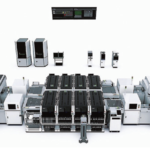ASIA ELECTRONICS INDUSTRYYOUR WINDOW TO SMART MANUFACTURING
Alliance Takes Simulations to New Heights
Rockwell Automation, Inc. has partnered with engineering simulation and 3D design software provider Ansys, Inc. to optimize industrial operations. This will give automation and process engineers new ways to use simulation and improve the design, deployment, and performance of industrial operations.
To enable this partnership, the enhanced Studio 5000 Simulation Interface of Rockwell Automation now connects with Ansys Twin Builder.
The Studio 5000 Simulation Interface connects Rockwell Automation industrial control systems with simulation and modeling tools. The latest release of the tool expands that connectivity to Ansys Twin Builder, a software used to create simulation-based digital twins of physical assets.
The software uses multi-physics to identify how real-world elements like flow rates, mechanical stresses, and thermal profiles can impact equipment performance and health.
Julie Robinson, Business Manager at Rockwell Automation said by connecting a control system to Ansys Twin Builder, users can simulate complex physical processes and give realistic inputs to the control system. “This can provide tremendous insights throughout the equipment lifecycle. For example, running a simulation model in parallel to a physical system during production can reveal opportunities to optimize performance in real time.”

Saves Time, Cost
Engineers can use digital twins and simulation to improve system design and delivery in many ways, one of which by creating and testing equipment designs in a virtual space. This will save engineering time and reduce the need to build costly physical prototypes.
Digital twins also help engineers to commission equipment to avoid surprises during start-ups at production sites. Engineers can also compare simulated and actual system performance to identify adjustments that can improve efficiency, output, and more.
By using digital twin and simulation, engineers can also test process changes in a virtual space to boost performance aspects. It can also help them calculate the remaining life of components to prevent unplanned downtime as part of a predictive maintenance strategy.
Simulation can also provide operator training in virtual environment, even on uncommon or dangerous scenarios.
Value for Users
Shane Emswiler, Senior Vice president of Products at Ansys said connecting the digital and physical worlds with Studio 5000 Simulation Interface creates tremendous value for users.
Emswiler said, “It can help them go from conceptual designs to physical equipment faster and at a lower cost. It can provide useful new insights during production. For instance, users can apply what-if scenarios to understand the impact of changes on a process. They can create virtual sensors to estimate values that are otherwise too expensive or not possible to get today, and they can predict outcomes like failures that hurt the bottom line.”
The Studio 5000 Simulation Interface allows users to connect a digital twin to either an emulated or physical controller. Connecting to an emulated controller can help them optimize production at the design stage before they have a physical controller or equipment. Connecting to a physical controller allows them to create a digital twin of how the equipment should run and compare it against actual performance.




